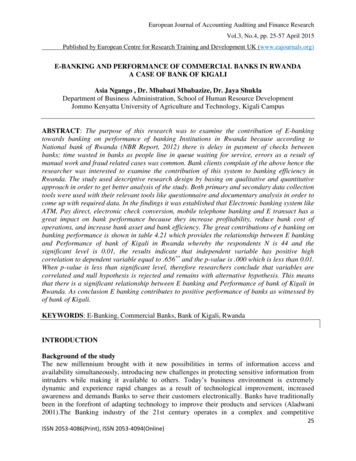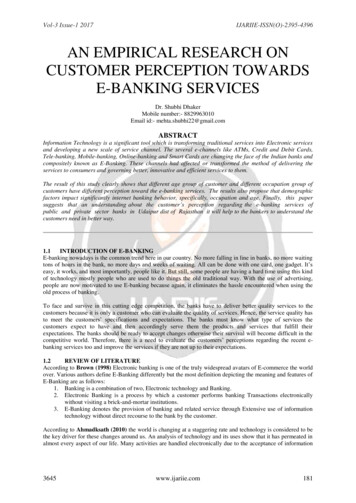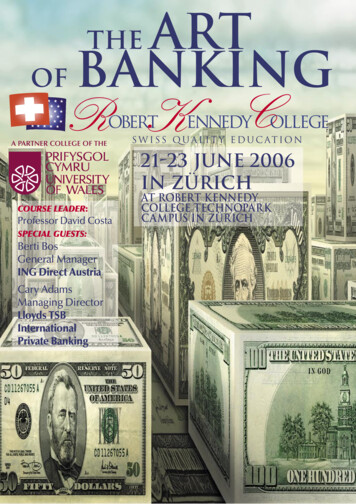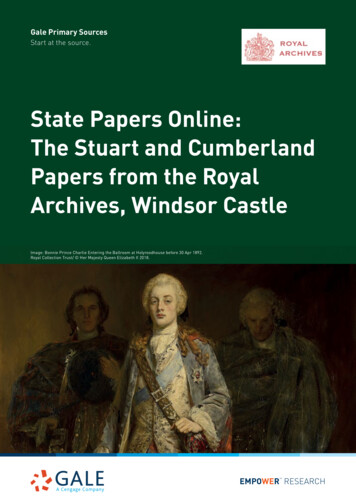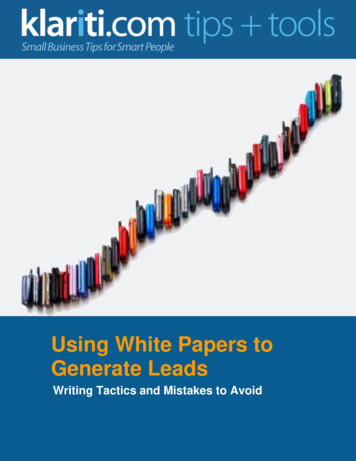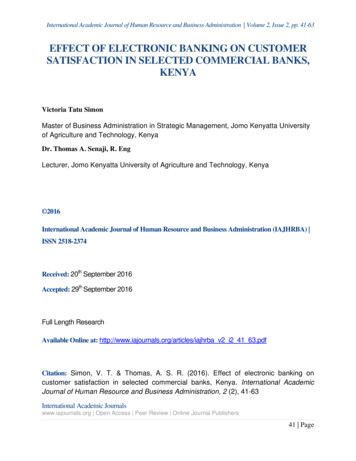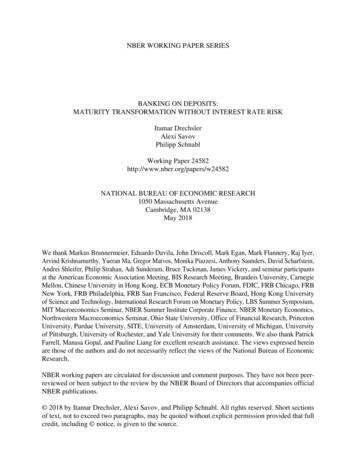
Transcription
NBER WORKING PAPER SERIESBANKING ON DEPOSITS:MATURITY TRANSFORMATION WITHOUT INTEREST RATE RISKItamar DrechslerAlexi SavovPhilipp SchnablWorking Paper 24582http://www.nber.org/papers/w24582NATIONAL BUREAU OF ECONOMIC RESEARCH1050 Massachusetts AvenueCambridge, MA 02138May 2018We thank Markus Brunnermeier, Eduardo Davila, John Driscoll, Mark Egan, Mark Flannery, Raj Iyer,Arvind Krishnamurthy, Yueran Ma, Gregor Matvos, Monika Piazzesi, Anthony Saunders, David Scharfstein,Andrei Shleifer, Philip Strahan, Adi Sunderam, Bruce Tuckman, James Vickery, and seminar participantsat the American Economic Association Meeting, BIS Research Meeting, Brandeis University, CarnegieMellon, Chinese University in Hong Kong, ECB Monetary Policy Forum, FDIC, FRB Chicago, FRBNew York, FRB Philadelphia, FRB San Francisco, Federal Reserve Board, Hong Kong Universityof Science and Technology, International Research Forum on Monetary Policy, LBS Summer Symposium,MIT Macroeconomics Seminar, NBER Summer Institute Corporate Finance, NBER Monetary Economics,Northwestern Macroeconomics Seminar, Ohio State University, Office of Financial Research, PrincetonUniversity, Purdue University, SITE, University of Amsterdam, University of Michigan, Universityof Pittsburgh, University of Rochester, and Yale University for their comments. We also thank PatrickFarrell, Manasa Gopal, and Pauline Liang for excellent research assistance. The views expressed hereinare those of the authors and do not necessarily reflect the views of the National Bureau of EconomicResearch.NBER working papers are circulated for discussion and comment purposes. They have not been peerreviewed or been subject to the review by the NBER Board of Directors that accompanies officialNBER publications. 2018 by Itamar Drechsler, Alexi Savov, and Philipp Schnabl. All rights reserved. Short sectionsof text, not to exceed two paragraphs, may be quoted without explicit permission provided that fullcredit, including notice, is given to the source.
Banking on Deposits: Maturity Transformation without Interest Rate RiskItamar Drechsler, Alexi Savov, and Philipp SchnablNBER Working Paper No. 24582May 2018, Revised January 2020JEL No. E43,E52,G21,G31ABSTRACTWe show that maturity transformation does not expose banks to significant interest rate risk it hedgesit. This is due to banks' deposit franchise. The deposit franchise gives banks substantial market powerover deposits, allowing them to pay deposit rates that are low and insensitive to market interest rates.Maintaining this power requires banks to incur large, interest-insensitive operating costs, so that thetotal costs of deposits are similar to fixed-rate, long-term debt. Hedging these costs therefore requiresbanks to lend long term i.e., to do maturity transformation. As predicted by this theory, we documentthat banks' net interest margins have been highly stable and insensitive to interest rates, and banks'net worth is largely insulated from monetary policy shocks. We further show that banks match theinterest-rate sensitivities of their expenses and income one-for-one, so that banks with less interest-sensitivedeposits (more market power) hold assets with substantially longer duration. Our results show thatdeposits are special because they are short-term and yet have interest-insensitive costs, which explainswhy banks are able to supply long-term credit.Itamar DrechslerWharton SchoolUniversity of Pennsylvania3620 Locust WalkPhiladelphia, PA 19104and NBERidrechsl@wharton.upenn.eduAlexi SavovStern School of BusinessNew York University44 West Fourth Street, Suite 9-80New York, NY 10012and NBERasavov@stern.nyu.eduPhilipp SchnablStern School of BusinessNew York University44 West Fourth StreetNew York, NY 10012and NBERschnabl@stern.nyu.edu
IIntroductionA defining function of banks is maturity transformation—borrowing short term and lendinglong term. This function is important because it supplies firms with long-term credit andhouseholds with short-term, liquid deposits. In textbook models, banks engage in maturitytransformation to earn the average difference between the long- and short-term rates—theterm premium—but this exposes them to interest rate risk. An unexpected increase in theshort rate makes banks’ interest expenses rise relative to interest income, pushing downnet interest margins and depleting banks’ capital. Interest rate risk is therefore viewed asfundamental to the economic model of banking, and it underlies discussion of how monetarypolicy impacts the banking sector.1In this paper, we show that in fact banks do not take on interest rate risk, despite havinga large maturity mismatch. The reason for this is the deposit franchise. Because of thedeposit franchise, maturity transformation actually reduces the amount of risk banks takeon. The deposit franchise has two essential properties that drive this result. The first is thatit gives banks market power over retail deposits, which allows them to borrow at rates thatare both low and insensitive to the market short rate. The second is that running a depositfranchise incurs high costs (branches, salaries, marketing), but these costs are largely fixedand hence also insensitive to the short rate. Therefore, even though deposits are short-term,funding via a deposit franchise resembles funding with long-term fixed-rate debt.This makes it natural for banks to hedge their deposit franchise by holding long-termfixed-rate assets. And since deposits are very large, so too are banks’ long-term asset holdings. Thus, a big maturity mismatch actually insulates banks’ profits from interest rate risk.We show empirically that this is true in the aggregate: bank profits are insensitive to evenlarge fluctuations in interest rates. It is also true in the cross section: banks that have astronger deposit franchise—and hence less sensitive interest expenses—hold more long-termassets. Moreover, there is a close quantitative match: banks with less sensitive interest expenses have one-for-one less sensitive interest income, which makes their profits fully hedged1In 2010, Federal Reserve Vice Chairman Donald Kohn argued that “Intermediaries need to be sure thatas the economy recovers, they aren’t also hit by the interest rate risk that often accompanies this sort ofmismatch in asset and liability maturities” (Kohn 2010). See also Boivin, Kiley, and Mishkin (2010).1
with respect to interest rates.Our findings have several important implications. First, they explain why deposit takingand long-term lending take place within the same institution, thereby providing a new answer to one of the fundamental questions in banking (e.g., Kashyap, Rajan, and Stein 2002).This question underlies the renewed debate surrounding narrow banking, which argues forseparating deposit taking from long-term lending (Friedman 1960, Cochrane 2014). Our results suggest that narrow banking could make banks more exposed to interest rate risk andreduce the supply of long-term credit.2 Second, our findings have implications for the transmission of monetary policy. In particular, they imply that banks are largely insulated fromthe balance sheet channel of monetary policy, the idea that interest rate changes influencebank lending by shocking their net worth (Bernanke and Gertler 1989, Bernanke, Gertler,and Gilchrist 1999).3 More broadly, our results show that, in a world where interest ratesfluctuate widely, the deposit franchise is the reason why banks can provide long-term loanswithout taking on interest rate risk.We begin the analysis by documenting that banks do in fact engage in significant maturitytransformation. Aggregate bank assets have an average estimated duration of 4.2 years,versus only 0.4 years for liabilities. This mismatch of about 4 years is large and stableover time. It implies that if banks paid market rates on their liabilities (as assumed in thetextbook model), then a 100-bps level shock to interest rates would cause a cumulative 400bps reduction in net interest margins (interest income minus interest expenses, divided byassets) over the following years. This loss in profits would lead to a 4% decline in the bookvalue of assets relative to liabilities over the same period. This is a very large hit for banks;it amounts to four years worth of profits given that the industry return on assets is just 1%.Although it would take time for the losses to be reflected in book values, investors wouldimmediately price in the full 4% drop in market values. And since banks are levered ten toone, the 4% drop in assets would translate to a 40% drop in banks’ stock prices.Yet in practice we find that a 100-bps shock to interest rates induces only a 4.2% drop2We understand narrow banking as allowing banks to invest only in short-term safe claims, precisely toavoid the interest-rate exposure that the literature associates with maturity transformation.3Drechsler, Savov, and Schnabl (2017) present an alternative channel of monetary policy that does notrely on variation in banks’ net worth.2
in bank stock prices, a value that is an order of magnitude smaller than that implied by theduration mismatch. We obtain this result by regressing the return on a portfolio of bankstocks on the change in the one-year rate around FOMC meetings. In addition to beingsmall, this sensitivity is very similar to that of the overall market portfolio (which drops by3.7%), and is close to the median for the Fama-French 49 industries. Banks are thus no moreexposed to interest rate shocks than the typical non-financial firm.4To understand this result, we look at the interest rate sensitivity of banks’ cash flows. Wefind that, consistent with their low equity sensitivity but in stark contrast to the textbookview, aggregate bank cash flows are insensitive to interest rate changes. Since 1955 netinterest margins (NIM) have stayed in a narrow band between 2.2% and 3.8%, even as theshort rate has fluctuated widely and persistently between 0% and 16%. Furthermore, yearlyNIM changes have had a standard deviation of just 0.15%, and zero correlation with changesin the short rate. Thus, fluctuations in NIM have been both extremely small and unrelatedto changes in interest rates.We show that the insensitivity of NIM is explained by banks’ deposit franchise. Wedo so by breaking down NIM into its two components, interest income and interest expense(divided by assets in each case), and comparing the two components’ interest rate sensitivties.We find that interest income has a low sensitivity to the short rate. This is expected becausebanks’ assets are primarily long-term and fixed-rate, hence the income they generate is lockedin for term. The surprising finding is that the sensitivity of interest expense is just as low,despite the fact that banks’ liabilities are overwhelmingly of zero and near-zero maturity.The explanation for this apparent paradox is that having a deposit franchise gives bankssubstantial market power over retail deposits (Drechsler, Savov, and Schnabl 2017), whichallows them to keep deposit rates low even when the market short rate rises. And sinceretail (core) deposits comprise over 70% of bank liabilities, this low sensitivity carries over tobanks’ overall interest expense. The deposit franchise thus allows banks to simultaneouslyhave a large duration mismatch and a near-perfect match of the interest rate sensitivities oftheir income and expenses.4We interpret the impact of interest rates on equity values as a discount rate shock that affects bothnon-financial firms and banks (Bernanke and Kuttner (2005)). The important result is that there is noadditional effect for banks relative to non-financial firms.3
Of course, a deposit franchise does not come for free. To the contrary, banks pay highoperating costs to maintain their deposit franchise. They invest in a network of retail outlets,in marketing their products, in servicing their customers, and in offering the latest financialtechnologies. These costs account for the large 2% to 3% drop from banks’ NIM to theirbottom-line return on assets (ROA). Yet while these costs are high, they do not vary withinterest rates and are quite stable. Indeed, they resemble the operating expenses of nonfinancial firms. As a result, the insensitivity of NIM flows through to ROA.We present a simple model that captures these findings. In the model, banks pay a fixedper-period operating cost to run their deposit franchise. This gives them market power,which allows them to pay a deposit rate that is only a fixed fraction of the market shortterm rate, as in Drechsler, Savov, and Schnabl (2017). The model shows that the depositfranchise functions like an interest rate swap in which the bank pays the fixed leg and receivesthe floating leg. The fixed leg is the operating cost the bank pays to obtain market power,while the floating leg is the interest spread it charges depositors by paying them a low depositrate. The value of the deposit franchise can then be viewed as the net present value of thisswap (the present value of the floating leg minus the fixed leg). As with any interest rateswap, this value is exposed to interest rate changes. In particular, an increase in interestrates causes the present value of the fixed leg to fall, and since the swap is short the fixed leg,the value of the deposit franchise rises.5 Thus, the deposit franchise has a positive exposureto interest rates; equivalently, it has negative interest rate duration.Banks hedge their deposit franchise by taking the opposite exposure on their balancesheets. They do this by buying long-term fixed-rate assets (positive duration). When thereis free entry into the deposit market, the average deposit spread banks can charge just covertheir operating cost, and their net deposit rents are zero (i.e., the deposit franchise is fairlypriced). In this case, banks earn very thin margins at very high leverage, so it is crucialfor them to be tightly hedged. This requires them to perfectly match the sensitivities oftheir income and expenses to the short rate, so that their NIM and ROA are unexposed.Thus, the model explains why banks’ aggregate interest income and expenses have the same5We can also think of this result in terms of the forward value of the swap’s cash flows. The forwardvalue increases because the cash flows of the floating leg (the deposit spreads) rise relative to the cash flowsof the fixed leg (the operating costs).4
sensitivity to the short rate, and why aggregate NIM and ROA are so stable.An important insight from the model is that a fundamental part of banks’ interest rateexposure—the exposure of the deposit franchise—does not appear on the balance sheet.This is because neither the deposit spread banks earn, nor the operating cost they pay, arecapitalized. They do, however, figure prominently in banks’ income and expenses. Thisis why our analysis examines banks’ income and expenses, in combination with analyzingbanks’ net worth.The model further predicts that income and expense rate sensitivities should match bankby-bank. We test this prediction in the cross section using quarterly data on U.S. commercialbanks from 1984 to 2017.6 For each bank we estimate an interest expense sensitivity, whichwe call its interest expense beta, by regressing the change in its interest expense (divided byassets) on contemporaneous and lagged changes in the Fed funds rate, and then summingthe coefficients. We compute its interest income beta analogously. The average expense andincome betas are 0.354 and 0.371, respectively, with substantial variation in the 0.1 to 0.6range.We find that estimated expense and income betas match up very strongly across banks.Their correlations are 51% among all banks and 58% among the largest 5% of banks. Inaddition, the slopes from a regression of income betas on expense betas are 0.768 and 0.881,respectively. The fact that these slopes are close to one shows that there is close to onefor-one matching, as predicted by the model. These results are confirmed in two-stagepanel regressions with time fixed effects, which produce estimates that are more precise andeven closer to one for the large banks (0.993 for large banks, 0.773 for all banks). Thestrong matching makes banks’ profitability essentially unexposed: ROA betas (computedanalogously to expense betas) are close to zero across the board, as predicted by the model.Our estimates predict that a bank with an expense beta of one would have an incomebeta close to one. Although these betas are outside the range of variation in our sample,they have predictive power out of sample. In particular, they fit money market funds, whichobtain funding at the Fed funds rate (expense beta of one) and only hold short-term assets(income beta of one), hence they do not engage in maturity transformation.6We have posted the code for creating our sample and the sample itself on our websites.5
The insensitivity of banks’ profits to interest rate shocks is confirmed by our analysisof banks’ net worth. Following the methodology we used for the bank industry portfolio,we estimate firm-level “FOMC betas” for all publicly traded commercial banks. As in theaggregate, the average FOMC beta of banks is close to that of the market. More importantly,there is a flat relationship between banks’ FOMC betas and their expense and income betas.This shows that there is no relationship between a bank’s asset duration, as reflected in itsincome beta, and its net worth’s exposure to interest rate risk. While this result is verypuzzling from the vantage point of standard duration calculations, it is a clear and directimplication of our model.We also directly test whether banks with low expense betas hold more long-term, fixedrate assets. The answer is yes: there is a strong negative relationship between a bank’sinterest expense beta and the estimated duration of its assets. The slope of this relationshipis 3.4 years, which is large and close to the average duration of banks’ assets. It againextrapolates to fit the duration of money market fund assets.We consider two main alternative explanations for our matching results. One possibilityis that banks with higher expense betas face more run (liquidity) risk, and in response holdmore short-term assets as a buffer. Although this explanation does not predict one-for-onematching, it goes in the right direction. We address it by analyzing the shares of loansversus securities on banks’ balance sheets. Since loans are far less liquid than securities, theliquidity risk explanation predicts that high expense-beta banks should hold more securitiesand fewer loans. Yet we find the exact opposite: it is low expense-beta banks that hold moresecurities and fewer loans. This result is consistent with our model because the averageduration of securities is much higher than that of loans (8.4 years versus 3.8 years). Thus,liquidity risk is unlikely to explain our results.7We also consider the possibility that the sensitivity matching we observe is the productof market segmentation. Perhaps banks with more market power over deposits also havemore long-term lending opportunities. This explanation also does not predict one-for-one7In addition to loans and securities, a small fraction of banks (about 13%) make use of interest ratederivatives. In principle, banks can use these derivatives to hedge the interest rate exposure of their assets,yet the literature argues that they actually use them to increase it (Begenau, Piazzesi, and Schneider 2015).We show that our sensitivity matching results hold both for banks that do and do not use interest ratederivatives. Hence, derivatives use does not drive our results.6
matching. Nevertheless, we test it by checking if banks match the income betas of theirsecurities holdings to their expense betas. Since securities are bought and sold in openmarkets, they are not subject to market segmentation. We once again find close matching,even when we focus narrowly on banks’ holdings of Treasuries and agency MBS. This showsthat banks actively match their interest income and expense sensitivities.Finally, we provide direct evidence for the market power mechanism underlying the interest rate exposure of the deposit franchise in our model. We do so by exploiting threesources of geographic variation in market power in deposit provision. First, we use variationin local market concentration. We find that banks that raise deposits in more concentratedmarkets have lower expense betas and lower income betas, with a matching coefficient thatis again close to one.Second, we exploit branch-level variation in the rates banks pay on retail deposit products(interest checking, savings, and small time deposits) using data from the provider Ratewatch.These products are marketed directly to households in local markets and are thus the sourceof banks’ market power.8 We regress changes in the average rates of these retail depositsby county on Fed funds rate changes and obtain a county-level retail deposit beta. We thenaverage these county betas for each bank, weighting by the county’s share of the bank’sbranches, to obtain a bank-level retail deposit beta. Again, we find that variation in banks’market power, as captured by their retail deposit betas, is strongly related to their overallexpense betas, and that banks match this variation one-for-one with their income betas.Third, we add bank-time fixed effects to the estimation of the county-level retail depositbetas, and thus estimate these betas using only differences in retail deposit rates acrossbranches of the same bank. This purges them of any time-varying bank characteristics (e.g.,loan demand), giving us a clean measure of local market power. Using the purged betas asan instrument for banks’ overall expense betas, we again find one-for-one matching betweenincome and expense sensitivities.The rest of this paper is organized as follows. Section II discusses the related literature;Section III analyzes the aggregate time series; Section IV presents the model; Section Vdescribes the data; Section VI contains our main sensitivity matching results; Section VII8They are also well below the deposit insurance limit and hence immune to credit and run risk.7
looks at the asset side of bank balance sheets; Section VIII shows our results on marketpower; and Section IX concludes.IIRelated literatureBanks issue short-term deposits and make long-term loans. This dual function underliesmodern banking theory (Diamond and Dybvig 1983, Diamond 1984, Gorton and Pennacchi1990, Calomiris and Kahn 1991, Diamond and Rajan 2001, Kashyap, Rajan, and Stein 2002,Hanson, Shleifer, Stein, and Vishny 2015). Central to this literature is the liquidity risk thatarises from issuing run-prone deposits. Brunnermeier, Gorton, and Krishnamurthy (2012)and Bai, Krishnamurthy, and Weymuller (2016) provide quantitative assessments of thisliquidity risk. Our paper instead focuses on the interest rate risk that arises from maturitytransformation. Liquidity risk and interest rate risk are distinct since assets can be exposedto one but not the other. For instance, a floating-rate bond has liquidity risk but no interestrate risk (its duration is zero), whereas a Treasury bond has interest rate risk but no liquidityrisk (it can be resold easily). A broader distinction is that liquidity risk is concentrated infinancial crises whereas interest rate risk is first-order at all times.Other explanations for why banks engage in maturity transformation rely on the presenceof a term premium.9 In Diamond and Dybvig (1983), an implicit term premium arisesbecause households demand short-term claims but banks’ productive projects are long-term.In a recent class of dynamic general equilibrium models, maturity transformation in thefinancial sector varies with the magnitude of the term premium and effective risk aversion(He and Krishnamurthy 2013, Brunnermeier and Sannikov 2014, 2016, Drechsler, Savov, andSchnabl 2018). In Di Tella and Kurlat (2017), as in our paper, deposit rates are relativelyinsensitive to interest rate changes (due to a net worth constraint rather than market power).This makes banks less averse to interest rate risk than other agents and induces them tomaintain a maturity mismatch in order to earn the term premium. The result is a very largeequity exposure: a 1% increase in interest rates causes banks’ net worth to drop by 31%.9The term premium has declined and appears to have turned negative in recent years (seehttps://www.newyorkfed.org/research/data indicators/term premia.html). At the same time, banks’ maturity mismatch has remained unchanged.8
This is about the same as the textbook duration calculation but an order of magnitude largerthan what we find empirically.In contrast to this literature, our paper offers a risk-management rather than a risktaking explanation for banks’ maturity mismatch. Under the risk-management explanation,maturity mismatch reduces banks’ risk instead of increasing it. It also gives the strongquantitative prediction of one-for-one matching between between the interest sensitivities ofincome and expenses. We find this prediction to be borne out in the data.10Consistent with the risk-management explanation, Bank of America’s (2016) annual report reads, “Our overall goal is to manage interest rate risk so that movements in interestrates do not significantly adversely affect earnings and capital.” Appendix A provides furtherdiscussion of bank risk management taken directly from the annual reports of the largestU.S. banks.11 For formal models of bank risk management, see Froot, Scharfstein, and Stein(1994), Freixas and Rochet (2008), and Nagel and Purnanandam (2015).The empirical banking literature has looked at banks’ sensitivity to interest rate shocks.In a sample of 15 banks, Flannery (1981) finds that bank profits have a surprisingly lowexposure and frame this as a puzzle. Flannery (1983) finds the same result using a sampleof 60 small banks. Purnanandam (2007) argues that banks use interest rate derivatives toreduce the sensitivity of lending policy to interest rate shocks. Flannery and James (1984a)and English, den Heuvel, and Zakrajsek (2012) examine the cross section of banks’ stockprice exposures, but without comparing banks to other firms to see if they are special.The exposures in English, den Heuvel, and Zakrajsek (2012) are somewhat larger than oursbecause they include unscheduled emergency FOMC meetings. Nevertheless, they remainmuch smaller than predicted and only slightly larger than the exposure of non-financialfirms.12Other papers estimate banks’ interest rate risk exposure from balance sheet data. Bege10We do not argue that our theory represents the only reasons why banks engage in the lending. Weview our model as complimentary to existing models of why banks do informationally sensitive lending (e.g.,Diamond (1984)).11Our explanation is also consistent with case studies of bank interest rate risk management (e.g., Backus,Klapper, and Telmer (1994), Esty, Tufano, and Headley (1994).12Bernanke and Kuttner (2005) argues that the exposure of non-financial firms is due to an increase inthe equity risk premium. Nakamura and Steinsson (2018) argues that the exposure comes from improvedgrowth expectations.9
nau, Piazzesi, and Schneider (2015) and Begenau and Stafford (2018) find that bank balancesheets are heavily exposed to interest rates. Rampini, Viswanathan, and Vuillemey (2016)finds that banks hedge more of their interest rate risk if their net worth is larger. Our papershows that banks’ balance sheet exposure is hedged by the deposit franchise.13Our paper connects with Drechsler, Savov, and Schnabl (2017) to create the followingpicture of the impact of interest rates on banks. Banks invest heavily in building a depositfranchise, which gives them market power. They exploit this market power by charginghigher deposit spreads when interest rates rise. This makes deposits resemble long-termdebt and leads banks to hold long-term assets so that their NIM and net worth are hedged.Yet, as Drechsler, Savov, and Schnabl (2017) show, to charge these higher spreads bankshave to cut their deposit supply (like any monopolist), and must therefore contract theirbalance sheets. Thus, monetary policy exerts a powerful impact on banks’ credit supply,even as NIM and net worth are hedged.Under this framework banks with more market power have both a bigger maturity mismatch and more sensitive credit supply. This can explain the finding of Gomez, Landier,Sraer, and Thesmar (2016) that banks with a bigger income gap (a measure of maturity mismatch) contract lending by more when interest rate rise. Moreover, our results suggest thatbanks should become less willing to hold long-term assets as their deposits flow out. Thiscan shed light on the finding of Haddad and Sraer (2015) that the income gap negativelypredicts bond returns.A canonical example of interest rate risk in the financial sector comes from the Savingsand Loans (S&L) crisis of the 1980s. An unprecedented rise in interest rates inflicted severelosses on S&Ls, which were subject to a duration mismatch by regulation (White 1991). Therise in interest rates also triggered deposit outflows from commercial banks to money marketfunds, thereby leading to disintermediation in the banking sector and creating demand forsecuritization. We draw two important lessons from this historical episode. First, our datashows that unlike S&Ls commercial banks saw no decline in NIM during this period because13This point relates to the debate about whether bank balance sheets should be marked to market. Ouranalysis implies that for mark-to-market accounting to properly capture banks’ interest rate risk, the depositfranchise would have to be capitalized on the balance sheet. Otherwise, as long as income from the depositfranchise is booked only as it accrues over time, it is consistent to do
Wharton School University of Pennsylvania 3620 Locust Walk Philadelphia, PA 19104 and NBER idrechsl@wharton.upenn.edu Alexi Savov Stern School of Business New York University 44 West Fourth Street, Suite 9-80 New York, NY 10012 and NBER asavov@stern.nyu.edu Philipp Schnabl Stern School of Business New York University 44 West Fourth Street New .
